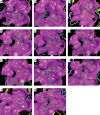Statins and the COVID-19 main protease: in silico evidence on direct interaction
- PMID: 32399094
- PMCID: PMC7212226
- DOI: 10.5114/aoms.2020.94655
Statins and the COVID-19 main protease: in silico evidence on direct interaction
Abstract
Introduction: No proven drug and no immunisation are yet available for COVID-19 disease. The SARS-CoV-2 main protease (Mpro), a key coronavirus enzyme, which is a potential drug target, has been successfully crystallised. There is evidence suggesting that statins exert anti-viral activity and may block the infectivity of enveloped viruses. The aim of this study was to assess whether statins are potential COVID-19 Mpro inhibitors, using a molecular docking study.
Material and methods: Molecular docking was performed using AutoDock/Vina, a computational docking program. SARS-CoV-2 Mpro was docked with all statins, while antiviral and antiretroviral drugs - favipiravir, nelfinavir, and lopinavir - were used as standards for comparison.
Results: The binding energies obtained from the docking of 6LU7 with native ligand favipiravir, nelfinavir, lopinavir, simvastatin, rosuvastatin, pravastatin, pitavastatin, lovastatin, fluvastatin, and atorvastatin were -6.8, -5.8, -7.9, -7.9, -7.0, -7.7, -6.6, -8.2, -7.4, -7.7, and -6.8 kcal/mol, respectively. The number of hydrogen bonds between statins and amino acid residues of Mpro were 7, 4, and 3 for rosuvastatin, pravastatin, and atorvastatin, respectively, while other statins had two hydrogen bonds.
Conclusions: These results indicate, based upon the binding energy of pitavastatin, rosuvastatin, lovastatin, and fluvastatin, that statins could be efficient SARS-CoV-2 Mpro inhibitors. This is supported by the fact that the effects of some statins, especially pitavastatin, have a binding energy that is even greater than that of protease or polymerase inhibitors. However, further research is necessary to investigate their potential use as drugs for COVID-19.
Keywords: 6LU7; COVID-2019; docking; main protease; statins.
Copyright: © 2020 Termedia & Banach.
Conflict of interest statement
The authors declare of interest related to the topic of this paper.
Figures
References
LinkOut - more resources
Full Text Sources
Other Literature Sources
Miscellaneous

